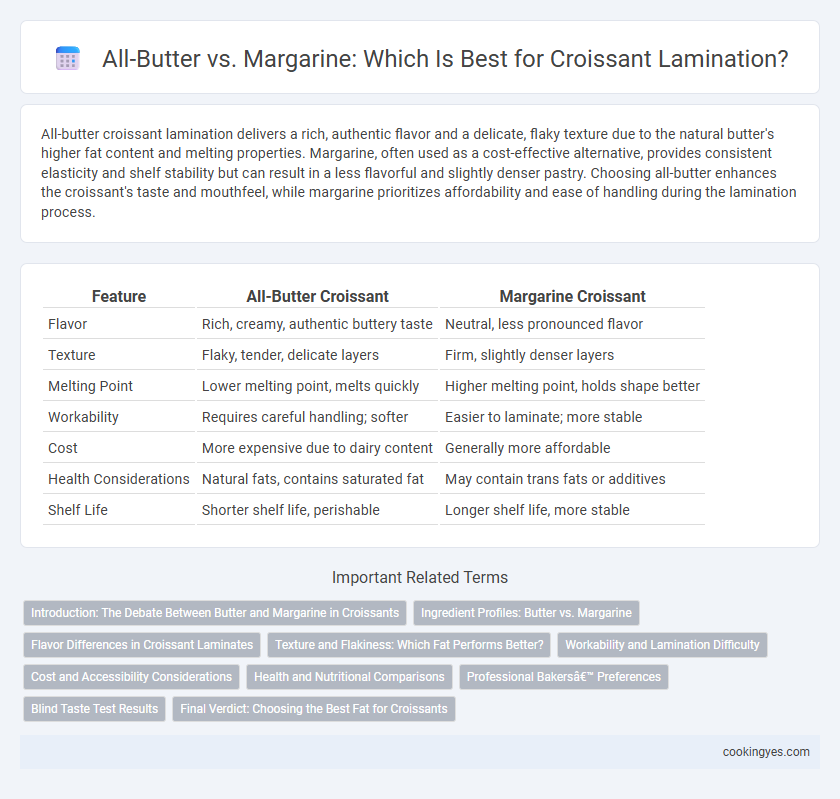All-butter croissant lamination delivers a rich, authentic flavor and a delicate, flaky texture due to the natural butter's higher fat content and melting properties. Margarine, often used as a cost-effective alternative, provides consistent elasticity and shelf stability but can result in a less flavorful and slightly denser pastry. Choosing all-butter enhances the croissant's taste and mouthfeel, while margarine prioritizes affordability and ease of handling during the lamination process.
Table of Comparison
| Feature | All-Butter Croissant | Margarine Croissant |
|---|---|---|
| Flavor | Rich, creamy, authentic buttery taste | Neutral, less pronounced flavor |
| Texture | Flaky, tender, delicate layers | Firm, slightly denser layers |
| Melting Point | Lower melting point, melts quickly | Higher melting point, holds shape better |
| Workability | Requires careful handling; softer | Easier to laminate; more stable |
| Cost | More expensive due to dairy content | Generally more affordable |
| Health Considerations | Natural fats, contains saturated fat | May contain trans fats or additives |
| Shelf Life | Shorter shelf life, perishable | Longer shelf life, more stable |
Introduction: The Debate Between Butter and Margarine in Croissants
All-butter croissants offer rich flavor and superior flakiness due to butter's high fat content and natural water composition, essential for creating delicate layers in lamination. Margarine, often used as a cost-effective alternative, provides higher melting points and longer shelf life but may compromise the buttery taste and texture traditional to classic French croissants. The debate centers on balancing authentic flavor and texture with practicality in croissant production.
Ingredient Profiles: Butter vs. Margarine
All-butter croissants use 82-85% fat butter, offering rich flavor and a tender, flaky texture due to short-chain milk fats. Margarine contains a blend of vegetable oils and water, typically with 80% fat content, providing a more consistent lamination but lacking butter's depth of flavor. The choice between butter and margarine directly impacts croissant flakiness, moisture retention, and taste, with butter enhancing aroma and margarine improving shelf stability.
Flavor Differences in Croissant Laminates
All-butter croissant laminates deliver a rich, creamy flavor with deep, natural dairy notes that enhance the pastry's buttery aroma and mouthfeel. Margarine, while often more cost-effective and consistent in performance, tends to impart a more neutral or slightly artificial taste, which can diminish the croissant's traditional flavor profile. The choice between all-butter and margarine significantly influences the sensory experience, with all-butter croissants prized for their authentic, luxurious flavor complexity.
Texture and Flakiness: Which Fat Performs Better?
All-butter croissants deliver superior texture and flakiness due to butter's higher melting point and water content, which creates distinct steam layers during lamination. Margarine often contains stabilizers and lower melting points, resulting in less crisp, denser layers that compromise the classic croissant flakiness. Bakers seeking authentic, delicate flakiness consistently prefer all-butter for optimal lamination performance.
Workability and Lamination Difficulty
All-butter croissants offer superior flavor and flakiness but present challenges in workability due to butter's lower plasticity and sensitivity to temperature, often requiring precise temperature control to prevent breakage during lamination. Margarine, with higher plasticity and stability, provides easier lamination and more consistent dough handling, making it preferable for beginner bakers or high-volume production. However, margarine's higher melting point can affect the croissant's texture and mouthfeel, potentially sacrificing the classic buttery flakiness prized in traditional French pastries.
Cost and Accessibility Considerations
All-butter croissants offer superior flavor and flakiness but come with higher ingredient costs and limited availability in some regions, impacting overall production expenses. Margarine serves as a more affordable and accessible alternative, facilitating consistent lamination due to its higher melting point and uniformity. Bakers must weigh the increased cost of premium butter against margarine's budget-friendly benefits when scaling croissant production.
Health and Nutritional Comparisons
All-butter croissants provide higher levels of natural saturated fats and fat-soluble vitamins like A and E, supporting essential bodily functions but contributing more cholesterol. Margarine-based croissants often contain less saturated fat and zero cholesterol, with some fortified blends including omega-3 fatty acids and plant sterols linked to heart health benefits. Choosing all-butter ensures a richer nutrient profile with minimally processed ingredients, while margarine offers a lower saturated fat option, making health impacts dependent on individual dietary needs and margarine formulation.
Professional Bakers’ Preferences
Professional bakers overwhelmingly prefer all-butter lamination for croissants due to its superior flavor, flakiness, and natural browning properties. All-butter croissants develop a richly layered, tender crumb with a distinct, buttery aroma that margarine-based doughs often cannot replicate. While margarine offers cost efficiency and ease of use, it typically results in less desirable texture and taste, leading professionals to favor high-quality European-style butter for optimal croissant production.
Blind Taste Test Results
Blind taste test results reveal a significant preference for all-butter croissants over those made with margarine, with 75% of participants favoring the richer, flakier texture and more authentic buttery flavor. All-butter lamination enhances the croissant's golden, crisp layers compared to margarine's often greasier and less distinct finish. These sensory differences highlight why bakeries prioritize high-quality butter in traditional French pastry preparation to meet consumer taste expectations.
Final Verdict: Choosing the Best Fat for Croissants
All-butter croissants offer superior flavor and flakiness due to butter's natural water content, which creates steam and distinct layers during lamination. Margarine provides a higher melting point, allowing for easier handling and consistent dough structure but often lacks the rich taste and aroma of real butter. Opting for all-butter fat maximizes authenticity and taste, making it the preferred choice for artisanal croissants despite margarine's functional advantages.
All-butter vs margarine for croissant lamination Infographic

 cookingyes.com
cookingyes.com